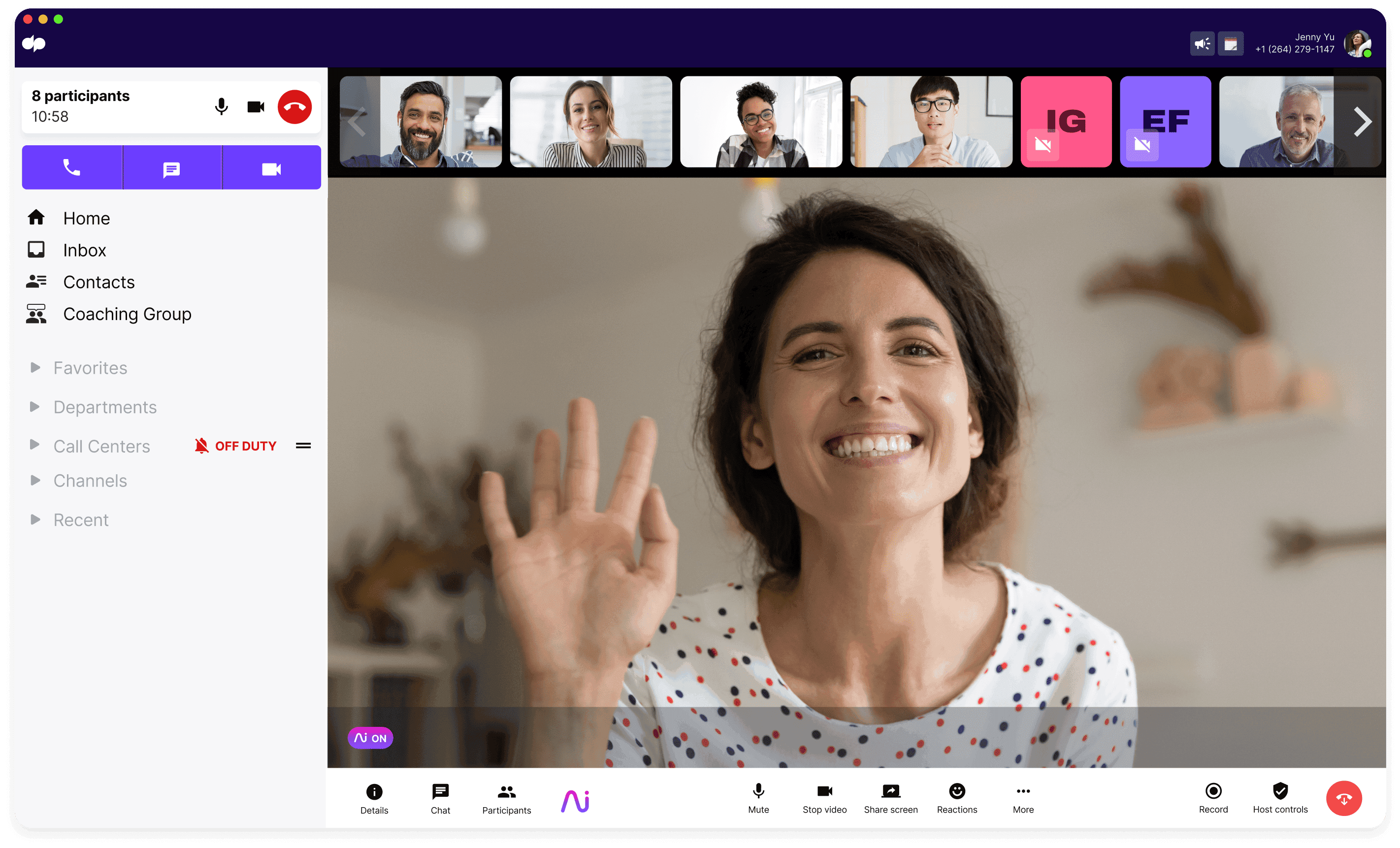Video codecs and Voice over IP codecs: How do they affect call quality?

Director of Quality Assurance

Product Manager

Share
From streaming movies and TV shows at home to making video and audio calls at work, video codecs and Voice over IP codecs are integral to a modern tech stack.
Video and VoIP (Voice over IP) codecs let you stream and send digital video files easily, without demanding a ton of bandwidth.
But what exactly is a video codec, and what sort of impact do they have on call quality? I’m going to unpack some of the terminology to give you a deeper understanding of the importance and usefulness of this communications technology.
What is a video codec?
Let’s look at a definition of codecs on their own, before we get into video codecs and Voice over IP codecs.
The word “codec” itself was made by mashing the words “encoder” and “decoder” together. In essence, codecs compress files and data so that they can travel through mediums like the internet, and then decompress them again so we can view and/or hear them.
Video codecs, in particular, have to reduce file sizes since video-based media files tend to take up quite a lot of space and are therefore hard to distribute. In other words, encoding the files properly is vital if they’re going to be sent anywhere.
Without a video or VoIP codec, it’s not possible to watch video streams, take part in video conferences, or talk to anyone via video chat:

It’s also worth noting that every codec has to be capable of both video encoding and decoding. If they’re not, they can’t work properly as codecs.
How does a video conference codec affect call quality?
Business communications need to be as seamless as possible, and video conferencing is no exception. That’s why your codec for video conferencing needs to be able to support your high quality standards.
A video conferencing codec needs to transmit the video data in your call, or in other words, it’s got to do both the encoding and the decoding.
Of course, a video conferencing codec that goes all-in on the video compression but doesn’t decompress well won’t give you the best video quality. On the other hand, video conferencing codecs that decompress beautifully but essentially transmit uncompressed information will have a negative impact on your frame rates and video playback speed.
Put simply, when choosing the right video codec, you need to be sure you can achieve an acceptable balance between video quality, optimal internet bandwidth utilization, and playback speed.
Another important factor to bear in mind is that you’re looking for lossy codecs. These give you high-definition videos and good data rates. Their counterparts, lossless codecs, transmit higher quality videos but come with major latency problems.
.RAW, .BMP, .GIF, and .PNG are common lossless file types, while most others are lossy. You can most easily tell whether a file is lossless or lossy by its size, because lossless files tend to be quite large.
Common types of video codecs
There are a range of common video codecs, each of which has different characteristics and use cases.
For video, Dialpad supports any SIP-capable endpoint with H.264. Dialpad also supports Opus, G.722.1, or G722 for audio codecs. Room Connector allows customers to leverage existing investments in SIP hardware and also offers a migration path into more modern room video conferencing hardware.
With that said, let’s look at the most common video codec types:
H.264/AVC
This codec type is broadly compatible across devices, as well as being easy to use. It’s great for low-latency streaming, which means that anyone using free video conferencing software (or any kind of conferencing software) can benefit from choosing H.264 codecs.
Since it came out around a decade ago, this video codec has gone through ten years’ worth of development, bug fixing, and patching. Unfortunately, though, this video codec type doesn’t support 4K HD video or higher quality streams.
VP9
A royalty-free codec type made and distributed by Google, VP9 replaced its predecessor, VP8, in 2013. This version of the software is faster, and it provides improved encoding and decoding.
VP9 can handle lots of different types of streams, including streams in 4K HD.However, there’s a major downside to VP9. It’s not compatible with Apple devices at all. That means it’s not suitable for organizations that use or even allow iOS devices, even if employees are working from home.
H.265/HEVC
The successor to MPEG-4 comes in the form of H.265. It’s able to compress files into even smaller versions of themselves without using more bandwidth. As a result, it’s able to handle high-definition video, letting you reach 8K resolutions and access advanced video streaming options, including subtitles.
H.265, then, is perfect for giving users HD experiences on home devices like TVs. However, H.265 isn’t designed, or suitable, for browser-based playback. It’s not great for streaming on mobile devices either, limiting its use cases and making it more difficult to use consistently in a work environment.
AV1
Like VP9, AV1 is an open source tool. It was co-developed by lots of big players in the streaming industry, including Netflix, Amazon, Google, and others.
This new tech hasn’t undergone as much trial and error patching as MPEG solutions. That means that it’s less likely to be consistently stable than some of the other items on this list.
H.266/VVC
VVC is a super high-definition codec to use for any video call. It’s capable of 16K streams, and provides high compression rates.
Unlike MPEG-4, and much like AV1, VVC is a new solution. It also comes with the benefits boasted by some of the other new tools, such as excellent compatibility with new tech. At the same time, it’s not gone through the extensive real-life testing that legacy solutions have. H.266 supports royalty-free video formats, including AVI, MOV, and VP9.
Understanding the different types of VoIP codec
There are five main kinds of VoIP codec that you can use to help make your internet-based communications as seamless as possible.
G.711
This codec type is a narrowband version that was created with telephony in mind. It processes audio signals ranging between 300 and 3400 Hz.
An ITU standard for audio companding, G.711 comes in two subtly different variants, which are designed for use in either North America and Japan, or the rest of the world.
G.722
G.722 is a wideband audio codec that gives users access to improved speech quality. It does that by processing a bigger range of sound, ranging from 50 to around 7000 Hz.
It’s been around since 1988, meaning that it predates most modern VoIP solutions. Nonetheless, G.722 is fully compatible with lots of contemporary VoIP-based tools and platforms, and is still considered both relevant and useful by today’s standards.
Please note that while wideband codecs by the names of G.722.1 and G.722.2 do exist, they’re not connected to G.722. They use different kinds of compression tech entirely.
G.729
This narrowband audio data compression tool is a vocoder-based algorithm that came about in 1996. There’s also a wideband extension of it, which is called G.729.1.
It has particularly low broadband requirements. Unfortunately, though, this codec isn’t ideal for every situation. It’s not designed to transmit information like fax documents or high-quality audio, so if that’s what you’re looking for, you probably won’t want to count on using G.729.
G.723.1
G.723.1 can operate at two bitrates. This essentially makes it a dual rate speech coder. Like G.279, this codec has limited bandwidth requirements, making it a great option for VoIP solutions. However, music or similar tones can’t be sent via G.723.1, though G.711 can help with that.
GSM 06.10
GSM 06.10 is also known as Full Rate, GSM-FR, or just GSM. Developed in the 1990s, this codec was the first of its kind, being a tool that relies on linear predictive coding to perform its speech coding functions.
GSM is a lossy speech compression tool, and it works on multimedia platforms. That’s why some VoIP services still use this older tool, despite some of the quality issues that are inherent in its design.
What’s the best VoIP codec?
The most common video codec for your device isn’t necessarily always the best one. Most importantly, when you’re considering making a VoIP codec comparison, you need to be absolutely certain that your codec options are all compatible with the tech solutions you use.
Your provider (or prospective provider) will be able to tell you about the codec(s) they use to power their VoIP solutions. This gives you a clear idea of whether a given solution meets or exceeds the needs of the traffic you’ll be sending through it.
This gives you a good idea of whether a given HD VoIP codec is the right solution for you.
How does VoIP codec affect call quality?
VoIP services all rely on the internet to function. They work, after all, by sending information across the internet to connect users.
Of course, this audiovisual information doesn’t just teleport itself from place to place, as convenient as that would be. Instead, it needs a VoIP audio codec (and video codec) to transmit digitized information from one place to another, in the form of data packets.
The VoIP audio codecs you use, therefore, inevitably impact the quality of your call. The better—or more suitable to your needs—a VoIP codec, the better the quality of the resulting video and audio.
How to calculate VoIP codecs’ bandwidth
To accurately calculate a VoIP codec’s bandwidth, you’ll need to find the values of three things: The total packet size, the PPS, and the bandwidth.
The packet size is made up of the sum of the headers and the voice payload size that you’re putting in. The PPS is found by dividing the codec bit rate by the voice payload size.As for the bandwidth, that comes from the total packet size multiplied by the PPS.
Once you’ve found the bandwidth, you’ll know the minimum threshold you can’t go below in terms of maintaining your VoIP codec’s connection.
Getting started with VoIP and video codecs
Getting yourself set up with a video codec for the first time might sound daunting, but don’t worry. If you’ve still got questions about the best codec for VoIP, read on to explore our FAQs. If not, you’re in the right place now.
When you choose Dialpad as your communications platform, you don't have to worry about codecs. We handle all the tech specifications for you, so you can simply enjoy a user-friendly interface and intuitive layout that make it perfectly suitable for total beginners.
There’s also the fact that Dialpad comes with a wide range of integrations with tools like Google Workspace and Microsoft 365, plugins, and features thanks to the fact that it’s a fully unified communications solution. Thanks to WebRTC, our voice-based products stay cutting-edge and ultra-modern, and also benefit from features like real-time voice transcription and live coaching. See how it works!
Try Dialpad Meetings' free plan
You get unlimited video meetings, virtual backgrounds, recordings, and more! Signup takes just a few minutes.
